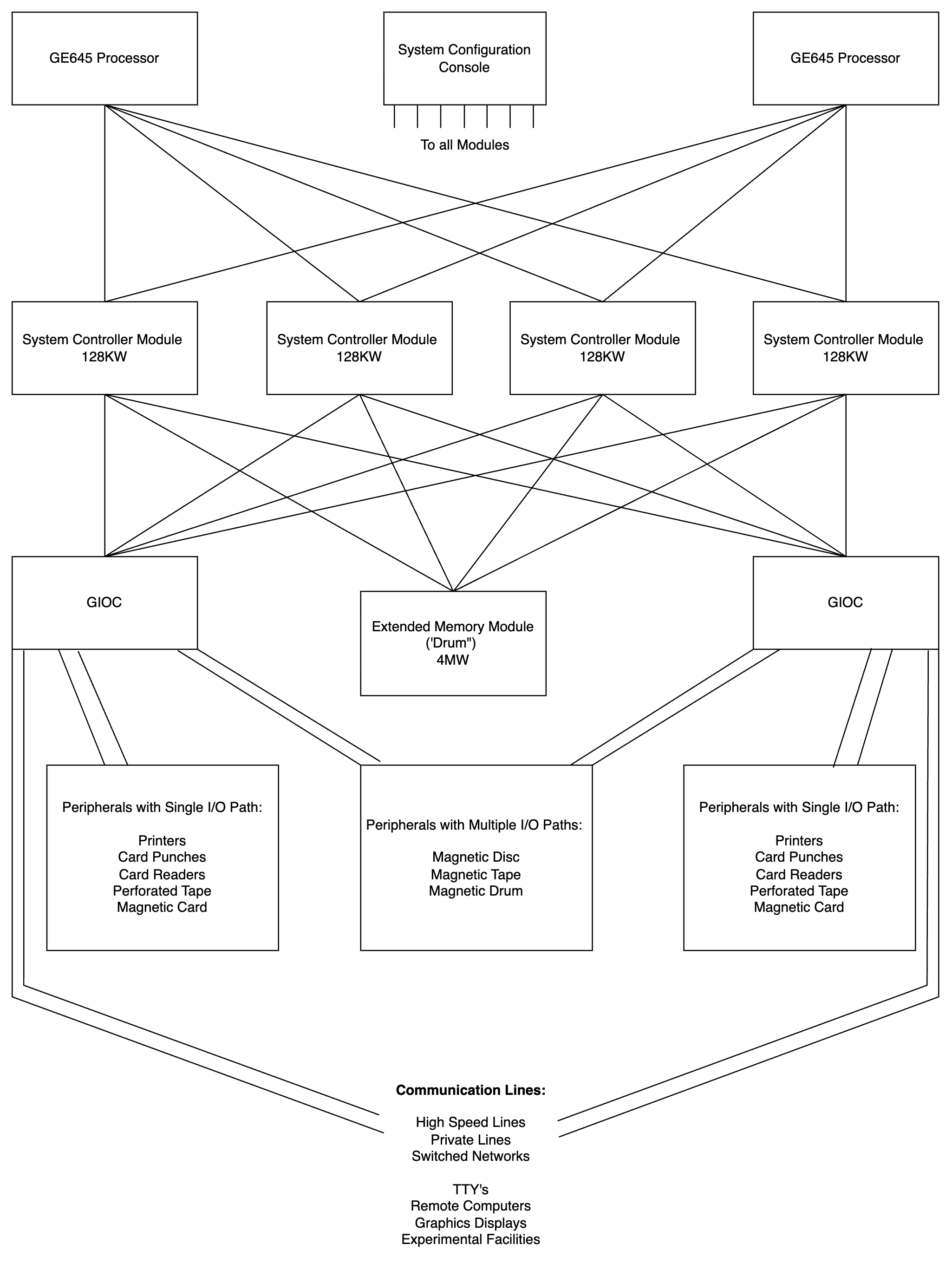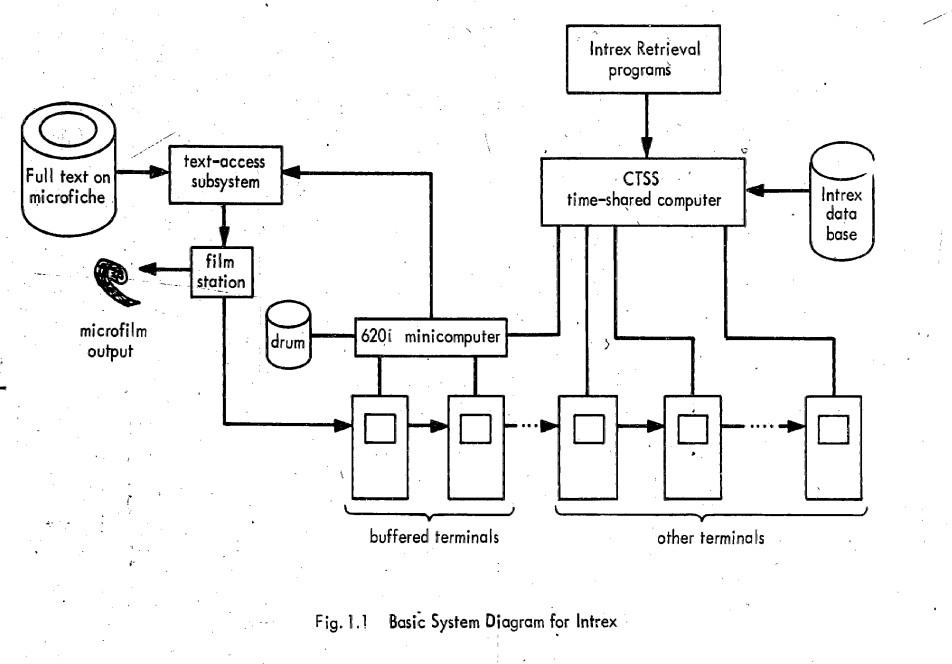|
Multics
Multics ("MULTiplexed Information and Computing Service") is an influential early time-sharing operating system based on the concept of a single-level memory.Dennis M. Ritchie, "The Evolution of the Unix Time-sharing System", Communications of the ACM, Vol. 17, 1984, pp. 365-375. It has been written that Multics "has influenced all modern operating systems since, from microcomputers to mainframes." Initial planning and development for Multics started in 1964, in Cambridge, Massachusetts. Originally it was a cooperative project led by MIT ( Project MAC with Fernando Corbató) along with General Electric and Bell Labs. It was developed on the GE 645 computer, which was specially designed for it; the first one was delivered to MIT in January 1967. GE offered their earlier 635 systems with the Dartmouth Time-Sharing System which they called "Mark I" and intended to offer the 645 with Multics as a larger successor. Bell withdrew from the project in 1969 as it became clear it would ... [...More Info...] [...Related Items...] OR: [Wikipedia] [Google] [Baidu] [Amazon] |
Honeywell 6180
The Honeywell 6000 series computers were a further development (using integrated circuits) of General Electric's 600-series mainframes manufactured by Honeywell International, Inc. from 1970 to 1989. Honeywell acquired the line when it purchased GE's computer division in 1970 and continued to develop them under a variety of names for many years. In 1989, Honeywell sold its computer division to the French company Groupe Bull who continued to market compatible machines. Models The high-end model was the 6080, with performance approximately 1 MIPS. Smaller models were the 6070, 6060, 6050, 6040, and 6030. In 1973, a low-end 6025 was introduced. The models with an even number as the next-to-last digit of the model number included an ''Enhanced Instruction Set'' feature (EIS), which added decimal arithmetic and storage-to-storage operations to the original word-oriented architecture. In 1973, Honeywell introduced the 6180, a 6000-series machine with addressing modifications ... [...More Info...] [...Related Items...] OR: [Wikipedia] [Google] [Baidu] [Amazon] |
GE-645
The GE 645 mainframe computer was a development of the GE 635 for use in the Multics project. This was the first computer that implemented a configurable hardware protected memory system. It was designed to satisfy the requirements of Project MAC to develop a platform that would host their proposed next generation time-sharing operating system (Multics) and to meet the requirements of a theorized computer utility. The system was the first truly symmetric multiprocessing machine to use virtual memory, it was also among the first machines to implement what is now known as a translation lookaside buffer, the foundational patent for which was granted to John Couleur and Edward Glaser. General Electric initially publicly announced the GE 645 at the Joint Computer Conference, Fall Joint Computer Conference in November 1965. At a subsequent press conference in December of that year it was announced that they would be working towards "broad commercial availability" of the system. However ... [...More Info...] [...Related Items...] OR: [Wikipedia] [Google] [Baidu] [Amazon] |
GE 645
The GE 645 mainframe computer was a development of the GE 635 for use in the Multics project. This was the first computer that implemented a configurable hardware protected memory system. It was designed to satisfy the requirements of Project MAC to develop a platform that would host their proposed next generation time-sharing operating system (Multics) and to meet the requirements of a theorized computer utility. The system was the first truly symmetric multiprocessing machine to use virtual memory, it was also among the first machines to implement what is now known as a translation lookaside buffer, the foundational patent for which was granted to John Couleur and Edward Glaser. General Electric initially publicly announced the GE 645 at the Fall Joint Computer Conference in November 1965. At a subsequent press conference in December of that year it was announced that they would be working towards "broad commercial availability" of the system. However they would subsequent ... [...More Info...] [...Related Items...] OR: [Wikipedia] [Google] [Baidu] [Amazon] |
Compatible Time-Sharing System
The Compatible Time-Sharing System (CTSS) was the first general purpose time-sharing operating system. Compatible Time Sharing referred to time sharing which was compatible with batch processing; it could offer both time sharing and batch processing concurrently. CTSS was developed at the MIT Computation Center ("Comp Center"). CTSS was first demonstrated on MIT's modified IBM 709 in November 1961. The hardware was replaced with a modified IBM 7090 in 1962 and later a modified IBM 7094 called the "blue machine" to distinguish it from the Project MAC CTSS IBM 7094. Routine service to MIT Comp Center users began in the summer of 1963 and was operated there until 1968. A second deployment of CTSS on a separate IBM 7094 that was received in October 1963 (the "red machine") was used early on in Project MAC until 1969 when the red machine was moved to the Information Processing Center and operated until July 20, 1973. CTSS ran on only those two machines; however, there were remot ... [...More Info...] [...Related Items...] OR: [Wikipedia] [Google] [Baidu] [Amazon] |
Unix
Unix (, ; trademarked as UNIX) is a family of multitasking, multi-user computer operating systems that derive from the original AT&T Unix, whose development started in 1969 at the Bell Labs research center by Ken Thompson, Dennis Ritchie, and others. Initially intended for use inside the Bell System, AT&T licensed Unix to outside parties in the late 1970s, leading to a variety of both academic and commercial Unix variants from vendors including University of California, Berkeley ( BSD), Microsoft (Xenix), Sun Microsystems ( SunOS/ Solaris), HP/ HPE ( HP-UX), and IBM ( AIX). The early versions of Unix—which are retrospectively referred to as " Research Unix"—ran on computers such as the PDP-11 and VAX; Unix was commonly used on minicomputers and mainframes from the 1970s onwards. It distinguished itself from its predecessors as the first portable operating system: almost the entire operating system is written in the C programming language (in 1973), which allows U ... [...More Info...] [...Related Items...] OR: [Wikipedia] [Google] [Baidu] [Amazon] |
PL/I
PL/I (Programming Language One, pronounced and sometimes written PL/1) is a procedural, imperative computer programming language initially developed by IBM. It is designed for scientific, engineering, business and system programming. It has been in continuous use by academic, commercial and industrial organizations since it was introduced in the 1960s. A PL/I American National Standards Institute (ANSI) technical standard, X3.53-1976, was published in 1976. PL/I's main domains are data processing, numerical computation, scientific computing, and system programming. It supports recursion, structured programming, linked data structure handling, fixed-point, floating-point, complex, character string handling, and bit string handling. The language syntax is English-like and suited for describing complex data formats with a wide set of functions available to verify and manipulate them. Early history In the 1950s and early 1960s, business and scientific users programmed fo ... [...More Info...] [...Related Items...] OR: [Wikipedia] [Google] [Baidu] [Amazon] |
Command-line Interface
A command-line interface (CLI) is a means of interacting with software via command (computing), commands each formatted as a line of text. Command-line interfaces emerged in the mid-1960s, on computer terminals, as an interactive and more user-friendly alternative to the non-interactive mode available with punched cards. For a long time, a CLI was the most common interface for software, but today a graphical user interface (GUI) is more common. Nonetheless, many programs such as operating system and software development utility software, utilities still provide CLI. A CLI enables automation, automating computer program, programs since commands can be stored in a scripting language, script computer file, file that can be used repeatedly. A script allows its contained commands to be executed as group; as a program; as a command. A CLI is made possible by command-line interpreters or command-line processors, which are programs that execute input commands. Alternatives to a CLI ... [...More Info...] [...Related Items...] OR: [Wikipedia] [Google] [Baidu] [Amazon] |
Stratus VOS
Stratus VOS (Virtual Operating System) is a proprietary operating system running on Stratus Technologies fault-tolerant computer systems. VOS is available on Stratus's ftServer and Continuum platforms. VOS customers use it to support high-volume transaction processing applications which require continuous availability. VOS is notable for being one of the few operating systems which run on fully lockstepped hardware. During the 1980s, an IBM version of Stratus VOS existed and was called the System/88 Operating System. History VOS was designed from its inception as a high-security transaction-processing environment tailored to fault-tolerant hardware. It incorporates much of the design experience that came out of the MIT/Bell-Laboratories/General-Electric (later Honeywell) Multics project. In 1984, Stratus added a UNIX System V implementation called Unix System Facilities (USF) to VOS, integrating Unix and VOS at the kernel level. In recent years, Stratus has added POSIX-com ... [...More Info...] [...Related Items...] OR: [Wikipedia] [Google] [Baidu] [Amazon] |
GEORGE (operating System)
GEORGE was the name given to a series of operating systems released by International Computers and Tabulators (ICT) in the 1960s, for the ICT 1900 series of computers. These included GEORGE 1, GEORGE 2, GEORGE 3, and GEORGE 4. Initially, the 1900 series machines, like the Ferranti-Packard 6000 on which they were based, ran a simple operating system known as Executive (operating system), Executive, which allowed the system operator to load and run programs from a Teletype Model 33 ASR based system console. In December 1964, ICT set up an Operating Systems Branch to develop a new operating system for the 1906/7. The branch was initially staffed with people being released by the end of work on the Orion Master Program, OMP operating system for the Ferranti Orion. The initial design of the new system, named George after the head of the Basic Programming Division George E. Felton, was based on ideas from the Orion and the spooling system of the Atlas Computer (Manchester), Atlas ... [...More Info...] [...Related Items...] OR: [Wikipedia] [Google] [Baidu] [Amazon] |
Honeywell International, Inc
Honeywell International Inc. is an American publicly traded, multinational conglomerate corporation headquartered in Charlotte, North Carolina. It primarily operates in four areas of business: aerospace, building automation, industrial automation, and energy and sustainability solutions (ESS). Honeywell also owns and operates Sandia National Laboratories under contract with the U.S. Department of Energy. Honeywell is a Fortune 500 company, ranked 115th in 2023. In 2024, the corporation had a global workforce of approximately 102,000 employees. As of 2023, the current chairman and chief executive officer is Vimal Kapur. The corporation's name, Honeywell International Inc., is a product of the merger of Honeywell Inc. and AlliedSignal in 1999. The corporation headquarters were consolidated with AlliedSignal's headquarters in Morristown, New Jersey. The combined company chose the name "Honeywell" because of the considerable brand recognition. Honeywell was a component of the Dow ... [...More Info...] [...Related Items...] OR: [Wikipedia] [Google] [Baidu] [Amazon] |






